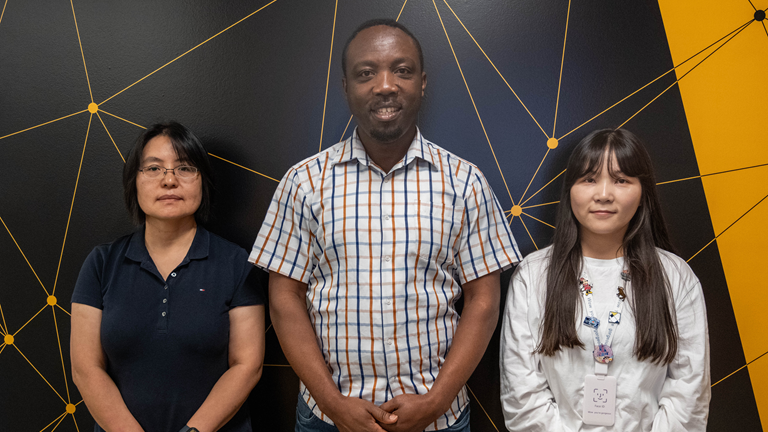July 28, 2025
New materials set the stage for more efficient lighting, cleaner solar energy systems and even compact LEDs for wearable medical devices.

At Mizzou Engineering, we’re focused on the future. This gives our researchers the creative audacity to look beyond the moment and build a better world for everyone.
Recently, a team of Mizzou faculty and students has developed a new copper-based material that could revolutionize sustainable lighting, offering a safer, more efficient alternative to toxic, lead-based LEDs. Their findings were published this spring in the journal Advanced Materials.
Manufacture of LEDs requires a type of material called perovskites, which are prized for their optical and electronic properties. For decades, they’ve powered advances in superconductors, solar panels and LEDs.
But most perovskites are lead-based and toxic. While lead-free alternatives have been explored, they’ve typically lacked the performance of their lead-based counterparts — until now.
Enter Peifen Zhu, assistant professor in the Department of Electrical Engineering and Computer Science, who is testing whether lead-free perovskites are not just safer, but also better.
A safer, smarter alternative
“Copper-based systems offer low toxicity, earth abundance and excellent optoelectronic properties, making them ideal for sustainable lighting technologies,” Zhu said.
Zhu and her team developed two solid perovskite-based powders: copper halide perovskite (Cs₃Cu₂Br₅), which glows bright blue when exposed to light or electricity, and cesium copper bromide (Cs₃Cu₂Cl₅), which glows green.
The powders achieved remarkable photoluminescence quantum yields (PLQY, a measure of how efficiently a material turns absorbed energy into light) of 100% and 92%, respectively. Commercial LEDs on the market today have a PLQY of 80-90%.
Zhu then used these powders and a yellow-emitting double perovskite to build highly efficient white LEDs.

“Almost all the energy they take in is turned into light, with very little waste,” Zhu said.
By adjusting the ratios of these three perovskites, Zhu and her team were able to create different shades of white light.
“We tuned the LEDs to mimic natural sunlight or for specific settings like home lighting, where most people prefer warmer tones; office or industrial lighting, where they want cooler tones; or medical environments, where high color accuracy is critical,” Zhu said.
Another notable aspect of Zhu’s research is the use of 3D printing to embed these materials into custom shapes — most perovskite research focuses on thin films — giving engineers control over how and where the light spreads.
“We can make the LED behave like a lamp or a spotlight, depending on the structure around it,” Zhu said. “We can focus the light forward like a flashlight or spread it out like a lantern. Or we can embed tiny LEDs in wearable or medical devices, delivering light exactly where it’s needed.”
Beyond lighting, these new materials could also be used in solar energy devices, indoor power systems and technologies that store or transmit data using light.
Forward-looking collaboration
Zhu’s project brought together students and postdocs from physics, materials science, chemistry and electrical engineering, whose diverse expertise was crucial in bridging material design, device fabrication and performance analysis.
“Students played an integral role — from material synthesis and device integration to data analysis and manuscript writing,” Zhu said. “Their hands-on contributions were central to the success of this work.”
The work highlights Mizzou Engineering’s strengths in sustainability-focused research, interdisciplinary collaboration and student-centered innovation, Zhu said, and reflects the university’s broader mission to lead in impactful, forward-looking science.
“We’re just beginning to explore the potential of these materials,” Zhu said. “As we refine the fabrication process, the possibilities for greener, smarter lighting only expand.”
Curious about building a better world — like we are? Explore Mizzou Engineering research!